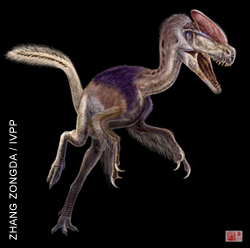
late Jurassic of China
Tyrannosaurus rex, meet your newest—oldest—cousin.
Florida State University paleobiologist Gregory M. Erickson sliced up some ancient dinosaur bones uncovered in China to help an international team of scientists identify a new genus and species. Despite striking skeletal differences and only subtle similarities, the FSU researcher determined that the two remarkably intact specimens were cousins of North America’s hulking Tyrannosaurus rex.
Make that distant cousins—the newfound, relatively diminutive 10-foot-long tyrannosauroids pre-dated the T. rex branch of their family tree by about 100 million years. That makes them the oldest known as well as the most primitive tyrannosauroid fossils ever found.
The discovery of the oldest tyrannosaurs is described in the journal Nature on Feb. 9. Erickson co-authored the paper with seven scientists from China, the United States and Canada.
Until now, tyrannosaurs such as T. rex were best known from the end of the Cretaceous period, about 65-70 million years ago. The new, nearly complete skeletons from China offer a snapshot of the earliest tyrannosauroid just after they morphed into a different branch of the family tree—95 million years before cousin T. rex ruled the roost.
Researchers say the identification of the oldest basal (primitive) tyrannosauroid yet will shed light on the early evolution and geographical distribution of its ancestors—small therapod dinosaurs known as coelurosaurs that were the closest relatives of modern-day birds.
"It’s not only the oldest tyrannosaur but also the sexiest," Erickson said, what with its flashy crest atop its small head—an extravagant ornament likely used only for attraction and display purposes and the first of its kind seen in the tyrannosaur’s predatory family. The creature has been named "Guanlong wucaii" and translated loosely from Chinese, that’s "crowned dragon five colors."
An internationally known expert on the development and evolution of the vertebrate musculoskeletal system, Erickson helped confirm the tyrannosauroid lineage of the two specimens by noting, among other features, the characteristic long hip, the U-shaped teeth and the fused nasal bridge. While they weren’t exactly T. rex look-alikes, they were definitely family.
But there were marked differences. Among them, in addition to its distinctive cranial crest, Guanlong was roughly 100 million years older and a fourth the size of its big, bad T. rex cousin. It had three fingers; T. rex had two. Its arms were longer and more delicate, its head smaller and its agility superior to the car-crushing, restroom-ripping monster of "Jurassic Park" movie fame.
While the sex of the two T. rex cousins was impossible to ascertain, Erickson determined their respective ages by examining the growth rings on the inside of their bones. Those of the larger animal had seven closely spaced rings—revealing rapid growth to young adulthood—followed by six widely spaced rings corresponding with slower growth to full maturity by the end of its relatively long 13-year life. Its cranial crest would have reached its full size by then, thus providing an accurate model for scientists. The bones of the smaller specimen had only six closely spaced rings and no widely spaced ones, indicating that it was a nearly grown juvenile who died prematurely, not simply a smaller, adult female.
"I study these animals as living organisms, not just as specimens on an evolutionary tree," Erickson said. "For me, it’s about how they lived, not just how they died."
Guanlong lived in China—its remains were found in the Junggar Basin of Xinjiang, in the western reaches of the Gobi Desert. Erickson contends that this discovery is merely the tip of the iceberg in that area. "China has been a hot spot for dinosaur fossils since the 1990s," he said.
Widely publicized research by Erickson—who also is known as an expert in dinosaur and crocodilian dentition, or bite force—has helped to generate interest in the sciences among young children, typically fascinated by animals such as dinosaurs and crocodiles. He is an assistant professor of anatomy and vertebrate paleobiology at FSU; curator of the Florida State University Museum; and a research associate at both The American Museum of Natural History in New York City and The Field Museum in Chicago. Erickson also is the animal expert on the National Geographic Channel series "Hunter and Hunted."



